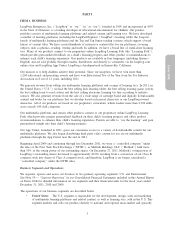LeapFrog 2011 Annual Report Download - page 21
Download and view the complete annual report
Please find page 21 of the 2011 LeapFrog annual report below. You can navigate through the pages in the report by either clicking on the pages listed below, or by using the keyword search tool below to find specific information within the annual report.
to correctly predict consumer preferences and successfully integrate popular third-party media and technology
with our own, it would negatively impact our operating results.
To remain competitive and stimulate consumer demand, we must continue to develop new products and
services and successfully manage frequent product introductions and transitions.
Due to the highly volatile and competitive nature of the industries in which we compete, we must continually
introduce new products and services, enhance existing products and services, and effectively stimulate
customer demand for new and upgraded products. In 2010 and 2011, we introduced a number of new products
and services to the market that represented a substantial portion of our 2011 sales and, in some cases,
represented a significant change in the way we interact with consumers. For example, in 2011 we launched
the LeapFrog App Center, which allows consumers to download content for use with some of our products
directly from us, instead of purchasing game cartridges from our retailers. In addition, some of the key
products launched in recent years, including our 2011 release of the LeapPad, have a high price point
compared to other children’s products. We cannot be sure that any new products or services will be widely
accepted and purchased by consumers or that we will be able to successfully manage product introductions
and transitions. Failure by consumers to accept our new products and services or to pay a higher price for
some of our key products, or our failure to manage product introductions and transitions, could adversely
affect our operating results.
We rely on a small group of retailers that together accounted for the vast majority of our gross sales
each year, and our dependence upon them may increase.
Our top three retailers in 2011 were Wal-Mart, Toys ‘‘R’’ Us and Target, which accounted for approximately
64% of the U.S. segment’s gross sales in 2011 and 65% in 2010. In addition, Wal-Mart and Toys ‘‘R’’ Us
accounted for approximately 30% of the international segment’s gross sales in 2011 and 32% in 2010. For the
foreseeable future, we expect to continue to rely on a small number of large retailers for the majority of our
sales domestically and abroad.
We do not have long-term agreements with any of our retailers. As a result, agreements with respect to
pricing, shelf space, cooperative advertising or special promotions, among other things, are subject to periodic
negotiation with each retailer. Retailers are continually re-evaluating shelf space allocations to optimize store
traffic and financial returns. This process has placed increasing pressure on the toy aisle, which in some
instances has been or may, in the future, be reduced in size. In addition, retailers make no binding long-term
commitments to us regarding purchase volumes and make all purchases by delivering one-time purchase
orders. If any of these retailers reduce their purchases from us, change the terms on which we conduct
business with them or experience a downturn in their business or constraint on their credit and ability to pay
their invoices as they become due, our business and operating results could be harmed.
We rely on our retail customers to successfully sell through our products to consumers. Economic and other
factors that affect retailers, such as liquidity problems, reduced access to credit, inability to raise capital,
reduced sales, consolidation in the retail sector and store closures, bankruptcies and lower consumer
confidence, will also affect us. Negative conditions for retailers, which are generally out of our control, could
adversely impact our ability to sell our products to consumers thereby affecting our operating results.
We depend on our suppliers for our components and raw materials, and our production or operating
margins would be harmed if the cost of our raw materials were to significantly increase or if these
suppliers are not able to meet our demand and alternative sources are not available.
Because some of the components used to make our products currently come from single or a limited number
of suppliers, we are subject to significant supply and pricing risks. Many components that are available from
multiple sources are at times subject to industry-wide shortages and significant commodity pricing
fluctuations. If our suppliers are unable to meet our demand for components and raw materials and if we are
unable to obtain an alternative source or if the price available from our current suppliers or an alternative
source is prohibitive, our ability to maintain timely and cost-effective production of our products would be
seriously harmed and our operating results would suffer. In addition, as we do not have long-term agreements
11
























